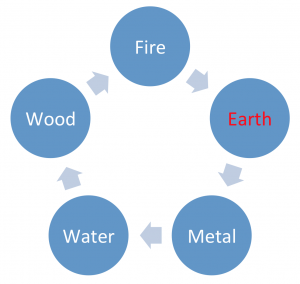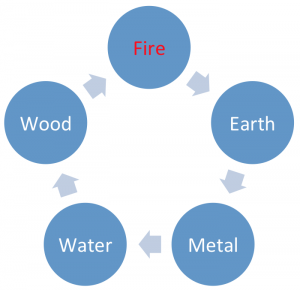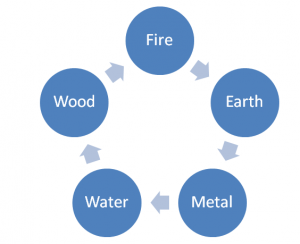We have now covered Water, Wood and Fire elements in previous blogs, and the Earth element is the second last element that we will discuss. In Chinese medicine theory, the Earth element houses our intellect or ‘Zhi’ in Chinese, ‘智‘. One with a balanced Earth element will have a clear mind. On the other hand, one with an imbalanced Earth element might have muddy thinking. In the element chart shown below, Fire supports Earth, Earth feeds Metal, Wood controls Earth, and Earth controls Water. They are inter-related; should one be out-of-balance, it will greatly affect the other elements.

The Earth element consists of the Stomach and Spleen organs, its meridian channels and vital pressure points. The functions of the Earth element are transformation, assimilation and satisfying needs. The Earth element acts like a Reserve Bank and a defence department of the body; it supplies nourishment, energy, Qi and blood to the body and also the body’s immunity system. The roles of the stomach are to break-down foods that are consumed by the body so that it can be transformed into useful energy or blood that circulates throughout the whole body.
The Earth element meridian channels covered most of the front of the body, and the tissue it governs are muscle and flesh. The sense organ for earth is the mouth, the sense is taste, physical manifestation is flesh, the body skin colour is yellow or brown when it is out of balance, its body odour is fragrant, and it produces sticky saliva when it’s out of tuned. The weather season for the earth element is late summer, the damaging climate for earth is humidity or dampness. The direction for earth is the centre. The spleen occupies the time of day from 9am to 11am. The stomach covers the time of day from 11am to 1pm; these are the prime time to nourish one’s Earth element. The Earth element likes sweet flavours, but too much sweet will damage the spleen. Negative emotions for the Earth element are worry, cynicism and jealousy; positive emotions for earth are sympathy, compassion and groundedness. Belching occurs when earth element is not running smoothly. The body parts that related to Earth element are knees, elbows and mid back. The Earth element also controls the lymphatic system of the body.
The Earth element can be damaged by the overeating of raw vegetables, oily fried foods, iced drinks, cold foods from the fridge and over-consumption of green or black tea. In wintertime, one might think that having raw salad is healthy and fresh diet, but according to Chinese medicine dietary theory, one should consume well cooked meals in winter instead.
Over consumption of raw cold foods can cause the development of fluid stagnation and dampness in the body system. The Spleen is responsible for transforming and transporting fluids, and congestion of fluids develops in the body when the Spleen energy is down. When the Spleen is low in energy, the organ is not producing the right amount of enzymes to break down the foods consumed and also weakens the body’s immunity due to lack of energy circulation and nutrient supply.
As mentioned before, the Earth element also looks after our intellect. Overthinking or paying too much attention to details can result in a compromised Earth Element. Cluttered thinking or fixated thinking would be an indication of an Earth imbalance. Lack of focus and foggy minds are caused by spleen energy deficiency. Spleen Qi deficiency is caused by excessive accumulation of dampness or phlegm in one’s body system.
A well balanced earth element has the ability to take in nourishment, to transform fresh food energy into Qi and Blood to supply to the body and to maintain good health and balance.
Physical and emotional symptoms that indicate an out-of-balanced Earth element are, overthinking, worrying, obsessing about details, lack of sympathy, lack of grounding, carving for sweets, clinging, nausea, diabetes, unexplained weight gain, fluffy muscles, submissive behaviour, low body immunity, stomach problems, irritable bowel syndromes.
The Stomach is the yang organ and the Spleen is the yin organ in the Earth element. The Spleen meridian consists of 21 pressure points. The first point of the spleen meridian Sp 1 starts from the medial side of the big toe nail, then it travels up on the medial side of the ankle. Sp 6 is a point where the three yin meridians meet which is located four fingers’ width above the medial malleolus. Sp 6 harmonises liver, nourishes kidney and regulates the menstrual cycle. Sp 9 is located on the medial side of the leg and below the knee, a diagnostic point for dampness accumulation in one’s body. Sp 10 is located 3 fingers width just above the medial edge of the superior border of the knee cap, and is an important point for treating knee problems. Then it ascends on the medial side of the leg, then through the crotch area to the floating rib, then continues to travel up to the 2nd rib. Sp 21 finishes up on the side of the body about 4 finger’s width down from the crease of the arm and the chest.
The stomach meridian starts from below the eyes at St 1, then travels down to the side of the mouth at St 4, and through St 6 located on the side of the jaw at the prominence of the masseter muscle. The meridian then travels up to the side of the forehead at St 8, then descends down to the clavicle bone at St 10 and through St 12 which is located in the middle of the clavicle bone, 4 fingers’ width from the mid-line of the body. Then there are 7 pressure points descending down the chest on top of the rib cage in line with the nipple, and 12 pressure points travelling down the abdomen about 2 fingers’ width from the mid-line. St 30 is located on the upper border of the pubic bone, then travels outward to the top of the leg. There are 4 pressure points on top of the thigh, and 6 pressure points on the lower leg along the shin-bone. An important pressure point here to note is St 36, about 4 fingers width down from the kneecap; it regulates the digestive system, menstrual cycle, strengthening the body’s immunity and overall energy flow. Then 5 pressure points travel down the middle of the foot to the last point St 45 on the second toe nail. There are 45 pressure points all together, making it the second longest meridian channel in the body.
Nourishing foods and drinks for the Earth element are millet, root vegetables such as carrot, potato and sweet potato, pumpkin, apple, apricot, banana, beans, beetroot, broccoli, cabbage, cherry, corn, cucumber, eggplant, fig, ginger, grapefruit, kelp, lettuce, lychee, orange, parsley, parsnip, pea, pear, peach, pineapple shiitake mushroom, strawberry, barley, oats, peanut, rice , soya bean, green tea, cider vinegar, and mineral water. Animal based nourishing foods for the Earth element are beef, butter, catfish, chicken, duck, lamb, milk, rabbit and veal.
Exercises that can help to strengthen the Earth element are singing, Karaoke, swimming, walking, Tai Chi, meridian stretches, Pilates, walking meditation, weight-based workouts, cycling and yoga.
Regular shiatsu massage can promote blood circulation and energy flow to release physical tension and emotional stress within the body and harmonise the organs and its meridians in the Earth element.
Benefits of the Meridian Stretches
Regular practice of Meridian stretches can increase your muscle tone, body flexibility, immunity, blood circulation, promote the smooth flow of energy in the twelve meridian channels and nourish each of the internal organs.
Spleen Meridian stretches (9am-11am)(yin)(earth)
Sit like a Japanese Geisha with your bottom touching the floor
Lift your right leg outward and use your big toe knuckle as the pivot point and repeat the same for your left leg as shown above. You should experience the stretching sensation on the interior side of your leg through to your groin.
Stomach Meridian stretches (11am-1pm)(yang)(earth)
Back to the Geisha sitting position.
Use your arms and elbows to support your body as you lower your back to the floor.
Advanced position (Please note, this is a very strong stretching position, not recommended for people with a bad back)


